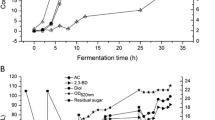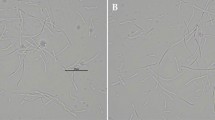Abstract
There are several problems limiting an industrial application of fossil fuel biodesulfurization, and one of them is the cost of culture media used to grow the microorganisms involved in the process. In this context, the utilization of alternative carbon sources resulting from agro-industrial by-products could be a strategy to reduce the investment in the operating expenses of a future industrial application. Recently, Gordonia alkanivorans 1B was described as a fructophilic desulfurizing bacterium, and this characteristic opens a new interest in alternative carbon sources rich in fructose. Thus, the goal of this study was to evaluate the utilization of sugar beet molasses (SBM) in the dibenzothiophene (DBT) desulfurization process using strain 1B. SBM firstly treated with 0.25 % BaCl2 (w/v) was used after sucrose acidic hydrolysis or in a simultaneous saccharification and fermentation process with a Zygosaccharomyces bailii Talf1 invertase (1 %), showing promising results. In optimal conditions, strain 1B presented a μ max of 0.0795 h−1, and all DBT was converted to 2-hydroxybiphenyl (250 μM) within 48 h with a maximum production rate of 7.78 μM h−1. Our results showed the high potential of SBM to be used in a future industrial fossil fuel biodesulfurization process using strain 1B.





Similar content being viewed by others
References
Borgne, L. S., & Quintero, R. (2003). Fuel Processing Technology, 81, 155–169.
Srivastava, V. C. (2012). Royal Society of Chemistry Advances, 2, 759–783.
Folsom, B. R., Schieche, D. R., DiGrazia, P. M., Werner, J., & Palmer, S. (1999). Applied and Environmental Microbiology, 65, 4967–4972.
Alves, L., Marques, S., Matos, J., Tenreiro, R., & Gírio, F. M. (2008). Chemosphere, 70, 967–973.
Mužic, M., & Sertić-Bionda, K. (2013). Chemical and Biochemical Engineering Quarterly, 11, 101–108.
Alves, L., Salgueiro, R., Rodrigues, C., Mesquita, E., Matos, J., & Gírio, F. M. (2005). Applied Biochemistry and Biotechnology, 120, 199–208.
Alves, L., & Paixão, S. M. (2014). New Biotechnology, 31, 73–79.
Silva, T. P., Paixão, S. M., Teixeira, A. V., Roseiro, J. C., & Alves, L. (2013). Journal of Chemical Technology and Biotechnology, 88, 919–923.
Paixão, S. M., Teixeira, P. D., Silva, T. P., Teixeira, A. V., & Alves, L. (2013). New Biotechnology, 30, 598–606.
Aggarwal, S., Karimi, I. A., & Ivan, G. R. (2013). Molecular BioSystems, 9, 2530–2540.
Drzyzga, O. (2012). Critical Reviews in Microbiology, 38, 300–316.
Wu, X., Lin, H., & Zhu, J. (2013). Bioresource Technology, 136, 351–359.
Kasavi, C., Finore, I., Lama, L., Nicolaus, B., Oliver, S. G., Oner, E. T., et al. (2012). Biomass and Bioenergy, 45, 230–238.
Taskin, M., Esim, N., & Ortucu, S. (2012). Food and Bioproducts Processing, 90, 773–779.
Yang, T., Rao, Z., Zhang, X., Xu, M., Xu, Z., & Yang, S. (2013). Applied Microbiology and Biotechnology, 97, 7651–7658.
Mohebali, G., Ball, A. S., Kaytash, A., & Rasek, B. (2008). Microbiology, 154, 878–885.
Kim, Y. J., Chang, J. H., Cho, K.-S., Ryu, H. W., & Chang, Y. K. (2004). Korean Journal of Chemical Engineering, 21, 436–441.
Aminsefat, A., Rasekh, B., & Ardakani, M. R. (2012). Microbiology, 81, 154–159.
Chang, J. H., Chang, Y. K., Cho, K.-S., & Chang, H. N. (2000). Biotechnology Letters, 22, 193–196.
Rhee, S., Chang, J. H., Chang, Y. K., & Chang, H. N. (1998). Applied and Environmental Microbiology, 64, 2327–2331.
Peng, Y., & Wen, J. (2010). Chemical and Biochemical Engineering Quarterly, 24, 85–94.
Mohebali, G., Ball, A. S., Rasekh, B., & Kaytash, A. (2007). Enzyme and Microbial Technology, 40, 578–584.
Jia, X., Wen, J. P., Sun, Z. P., Caiyin, Q. G., & Xie, S. P. (2006). Chemical Engineering Science, 61, 1987–2000.
Acknowledgments
The present work was financed by FEDER funds through POFC-COMPETE and by national funds through FCT (Fundação para a Ciência e a Tecnologia) in the scope of project Carbon4Desulf—FCOMP-01-0124-FEDER-013932 (Ex—PTDC/AAC-AMB/112841/2009).
Author information
Authors and Affiliations
Corresponding authors
Rights and permissions
About this article
Cite this article
Alves, L., Paixão, S.M. Enhancement of Dibenzothiophene Desulfurization by Gordonia alkanivorans Strain 1B Using Sugar Beet Molasses as Alternative Carbon Source. Appl Biochem Biotechnol 172, 3297–3305 (2014). https://doi.org/10.1007/s12010-014-0763-z
Received:
Accepted:
Published:
Issue Date:
DOI: https://doi.org/10.1007/s12010-014-0763-z




